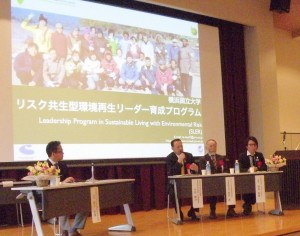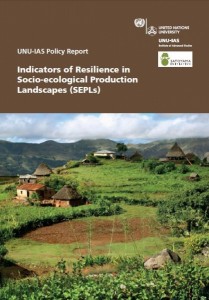Public Seminar on Indicators for Resilience in SEPLS
By: Dr. Kaoru Ichikawa (Research Fellow, United Nations University Institute of Advanced Studies)
Experts from Bioversity International and the United Nations Development Programme (UNDP) gave lectures in Yokohama, Japan on 22 April 2013. Both IPSI member organizations have taken leading roles in developing and piloting indicators for resilience in SEPLS. (detailed report available
here)
Ms. Nadia Bergamini (Bioversity International) gave a presentation on the development and field testing of the indicators. She explained that the indicators help to measure a community’s capacity to adapt to change while maintaining biodiversity. She then shared the results of the testing in Cuba, Kenya, Bolivia and Nepal and emphasized the usefulness of the indicators for establishing a common understanding at the community level of threats and for determining strategies to strengthen resilience. Looking forward, she underscored the importance of testing the indicators in a wider range of SEPLS including pastures, wetlands and coastal areas.
The second presentation was delivered by Ms. Diana Salvemini (UNDP), who described how the indicators are being used in COMDEKS sites to help measure and understand the resilience of the target landscapes and to identify necessary activities to strengthen resilience. She highlighted the usefulness of the indicators as a tool to promote a participatory process, and the importance of having a facilitator who is familiar with the community and can provide explanations in clear language tailored to local conditions. Looking forward, she emphasized the need for further improvements to the scoring system and strengthening of the social indicators.
The seminar also marked the launch of the latest UNU-IAS Policy Report on “
Developing Indicators of Resilience in Socio-ecological Production Landscapes”.
The New Commons: Governing Satoyama/Satoumi Landscapes for Human Well-being (Public Symposium)
By: Dr. Rizalita Rosalejos-Edpalina (Research Fellow, Kanazawa University)

Symposium speakers (from left to right): Prof. Tohru Nakashizuka, Prof. Koji Nakamura, Prof. Anantha Duraiappah, Mr. Shinjiro Imura, Mr. Yoshinari Ohtsumi, Mr. Taisuke Watanabe and Mr. Kazu Takemoto. (Photo: Kozue Suto)
The public symposium titled “New Commons: Governing Satoyama-Satoumi Landscapes for Human Well-being” was held on March 21, 2013, in Kanazawa, Japan. Researchers, professors and international experts whose research focuses on satoyama-satoumi, together with local stakeholders from the Wajima Chamber of Commerce, Kanazawa Agriculture and Ishikawa Prefectural Government, made presentations to help find innovative pathways towards sustainable use and management of landscapes.
Mr. Kazu Takemoto (Director,
UNU-IAS OUIK) welcomed the local and international experts to the symposium, described the collaboration efforts with Ishikawa Prefecture towards serious challenges ahead and opportunities for satoyama and satoumi landscapes, and expressed his hope that the symposium would help find innovative pathways towards sustainable use and management of these landscapes.
The first keynote presentation given by Prof. Tohru Nakashizuka (Tohoku University) emphasized that biodiversity is an integral part of people’s daily lives. Ways that biodiversity contributes to human
well-being, including the importance of providing habitats were extensively discussed. The second keynote speaker, Prof. Koji Nakamura (Kanazawa University) introduced the results of the
Japan Satoyama Satoumi Assessment and the plan for comprehensive assessment of satoyama/satoumi and human well-being in Ishikawa. In line with this, a 3-day design workshop was convened on March 19-21 to design a biodiversity and ecosystem services assessment in Ishikawa Prefecture with focus on the Noto Region. The third keynote speaker, Prof. Anantha Kumar Duraiappah (United Nations University International Human Dimensions Programme on Global Environmental Change) explained the concept of a new commons, which he defined as the spatial boundary that contains different ecosystem types that together produce a minimum set of regulating services (water, soil-nutrient recycling, flood protection, etc) to produce the bundle of provisioning services (rice, vegetables, etc). He emphasized the “new commons” as a key to the success of a more integrated and holistic approach of ecosystem management.
Three short presentations were delivered by local stakeholders, Mr. Yoshinari Ohtsumi (Wajima Chamber of Commerce / Ohtsumi Marine Products), Mr. Shinjiro Imura (Kanazawa Agriculture / Kanazawa Daichi Co. Ltd. / Asian Agriculture) and Mr. Taisuke Watanabe (Ishikawa Prefectural Government) regarding their activities and experiences that contribute to the revitalization of satoyama/satoumi in the Noto area. Specific experiences shared included the conversion of abandoned land into productive farmland planted with rice and vegetables using organic farming methods, the Satoyama Creation Fund, environment friendly initiatives like the
Noto Smart Drive project, and others.
Over the course of panel discussions, participants indicated key points of interests: 1) developing human resources; 2) evaluating resources and wealth beyond simple GDP measures; 3) the need to scale up successful initiatives and development interventions like the Satoyama Creation Fund, to improve their impact and effectiveness. The participation of a wide range of stakeholders contributed to the ongoing progress in satoyama/satoumi related activities. Finally, speakers shared insights encouraging renewed effort and commitment to revitalizing the landscapes and seascapes of Ishikawa Prefecture and the importance of nurturing young people’s interest in returning to lives based on production activities in satoyama and satoumi. (Follow the links for the
symposium flyer and
full report)
Symposium on Reconstruction in Japan’s Disaster-Hit Areas held at Yokohama National University
By: Professor Masanori Kobayashi (Yokohama National University)

Speakers during public symposium
Yokohama National University (YNU) organized a public symposium entitled “Reconstruction and Invigoration of Disaster-hit Areas – Viewpoints from Rikuzentakata” at the YNU Education and Culture Hall on 25 March 2013.
During the symposium, speakers reported on field visits to Rikuzentakata City in Iwate Prefecture and various activities conducted during the visits organized by the
Leadership Program in Sustainable Living With Environmental Risk of YNU, and discussed about challenges that disaster-hit communities are facing as well as their future perspectives with local representatives playing a leading role in their communities.
Workshop: Landscape Connectivity and Resilience
In early April, representatives of several IPSI member organizations (ANDES, Bioversity International, IUCN, UNEP-WCMC, UNU) joined other specialists at a
workshop to discuss resilience and connectivity of landscapes and seascapes with particular focus on IUCN Category V protected areas. A book-length manuscript building on these discussions is planned, and past publications by the specialist group can be
downloaded here.

Workshop participants gather outdoors for a group photo
Second Community Dialogue Seminar held in Japan’s Tsunami-Affected Tohoku Region
By: Prof. Masakado Kawata (Tohoku University) and Ms. Akane Minohara (United Nations University Institute of Advanced Studies)
Tohoku University and UNU-IAS, in collaboration with other IPSI members including the Ministry of the Environment of Japan and CEPA Japan and with support of Yamagata University, co-organised the Second Community-Dialogue Seminar for the Urato Islands, Miyagi Prefecture on 14 April 2013. More than 80 people, including about 40 people from the islands and a wide range of stakeholders participated in the event.
Building on the First Community-Dialogue Seminar held in August 2012, which mostly focused on the recovery from the earthquake and tsunami in March 2011, the focus of small-group discussion during the workshop was more on how to move forward to revitalize their communities in a sustainable and comfortable manner through multi-stakeholder collaboration.
Reports of this seminar (in English and Japanese) will be available shortly on the
Satoyama Initiative website.
New Publication authored by IPSI Members: “Indicators of Resilience in Socio-ecological Production Landscapes”

Cover of the UNU-IAS Policy Report (published in April 2013)
(Bioversity International, United Nations University Institute of Advanced Studies) Nadia Bergamini, Robert Blasiak, Pablo Eyzaguirre, Kaoru Ichikawa, Dunja Mijatovic, Fumiko Nakao and Suneetha M. Subramanian
Description: Over time, close interactions between humans and their surroundings have created resilient socio-ecological production landscapes (SEPLs) in many parts of the world. When wisely managed, SEPLs have the potential to sustain rich levels of biodiversity while enhancing human well-being. This policy report provides an in-depth look at the importance of developing a holistic set of indicators for policy-makers and communities to better understand the resilience of SEPLs. In addition, it shares first experiences and lessons learned from application of the indicators in Cuba’s
Cuchillas del Toa Biosphere Reserve. <
PDF Available Online









